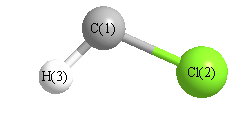Jump to
S2C1
Energy calculated at CCSD(T)=FULL/cc-pVTZ
| | hartrees |
|---|
| Energy at 0K | -498.273371 |
| Energy at 298.15K | -498.273239 |
| HF Energy | -497.853778 |
| Nuclear repulsion energy | 38.716966 |
The energy at 298.15K was derived from the energy at 0K
and an integrated heat capacity that used the calculated vibrational frequencies.
Geometric Data calculated at CCSD(T)=FULL/cc-pVTZ
Point Group is Cs
Cartesians (Å)
| Atom |
x (Å) |
y (Å) |
z (Å) |
|---|
| C1 |
0.045 |
1.194 |
0.000 |
| Cl2 |
0.045 |
-0.505 |
0.000 |
| H3 |
-1.033 |
1.426 |
0.000 |
Atom - Atom Distances (Å)
| |
C1 |
Cl2 |
H3 |
| C1 | | 1.6990 | 1.1025 |
Cl2 | 1.6990 | | 2.2114 | H3 | 1.1025 | 2.2114 | |
 More geometry information
More geometry information
Calculated Bond Angles
| atom1 |
atom2 |
atom3 |
angle |
|
atom1 |
atom2 |
atom3 |
angle |
| Cl2 |
C1 |
H3 |
102.142 |
|
Electronic energy levels
Charges, Dipole, Quadrupole and Polarizability
Jump to
S1C1
Energy calculated at CCSD(T)=FULL/cc-pVTZ
| | hartrees |
|---|
| Energy at 0K | -498.265444 |
| Energy at 298.15K | -498.265299 |
| HF Energy | -497.878334 |
| Nuclear repulsion energy | 39.041727 |
The energy at 298.15K was derived from the energy at 0K
and an integrated heat capacity that used the calculated vibrational frequencies.
Geometric Data calculated at CCSD(T)=FULL/cc-pVTZ
Point Group is Cs
Cartesians (Å)
| Atom |
x (Å) |
y (Å) |
z (Å) |
|---|
| C1 |
0.036 |
1.152 |
0.000 |
| Cl2 |
0.036 |
-0.512 |
0.000 |
| H3 |
-0.826 |
1.795 |
0.000 |
Atom - Atom Distances (Å)
| |
C1 |
Cl2 |
H3 |
| C1 | | 1.6640 | 1.0758 |
Cl2 | 1.6640 | | 2.4631 | H3 | 1.0758 | 2.4631 | |
 More geometry information
More geometry information
Calculated Bond Angles
| atom1 |
atom2 |
atom3 |
angle |
|
atom1 |
atom2 |
atom3 |
angle |
| Cl2 |
C1 |
H3 |
126.725 |
|
Electronic energy levels
Charges, Dipole, Quadrupole and Polarizability
